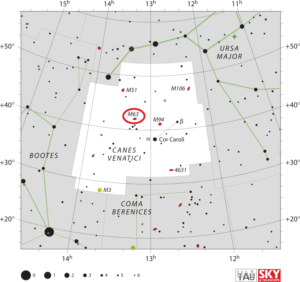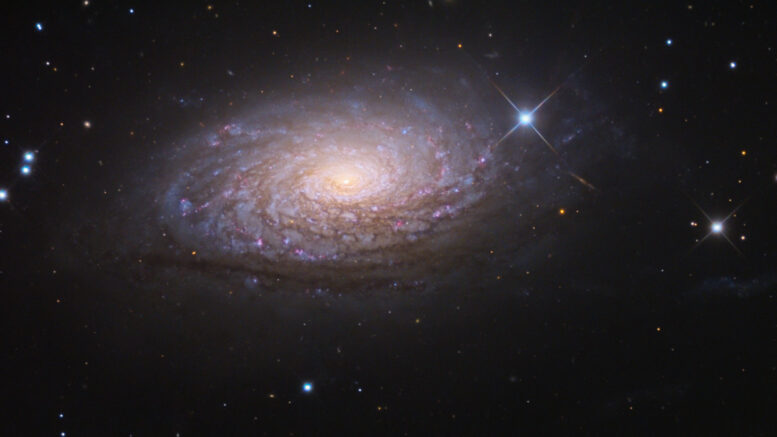The Sunflower Galaxy got its name from its yellow core and the shape of its arms resembling a sunflower.
| Description | |
| Visible From Pacific Northwest | December To June |
| Best Time To Observe | February, March, and April |
| Minimum Size Of Viewing Device | Medium Telescopes |
| Object Type | Spiral Galaxy |
| Designations | Messier 63, M63, NGC 5055, Sunflower Galaxy, PGC 46153, UGC 8334, B3 1313+422, IRAS F13135+4217, MCG+07-27-054, SDSS J131549.26+420145.8, Z 1313.5+4217 |
| Right Ascension | 13h 15m 49.3s |
| Declination | +42°01’45” |
| Constellation | Canes Venatici |
| Number Of Stars | More Than 400 Billion |
| Apparent magnitude | +9.3 |
| Apparent dimensions | 12′.6 x 7′.2 |
| Object Radius | 49,000 light years |
| Distance From Earth | 37 million light years |
History
The Sunflower Galaxy was discovered by Charles Messier’s friend and colleague Pierre Méchain on June 14, 1779. This was the first deep sky object discovered by Méchain. Messier subsequently included the galaxy in his catalogue as the 63rd entry, describing it as a nebula.
William Herschel observed the object less than a decade later and described it as a “very bright nebula, extending from north-preceding to south-following 9 or 10′ long, and near 4′ broad; it has a very brilliant nucleus.”
John Herschel catalogued M63 as h 1570 in May 1828 and later added it to the General Catalogue as GC 3474. He described the object as “bright; pretty much extended; very suddenly much brighter toward the middle, almost to a star [starlike nucleus], position angle 30deg north preceding [NW] to south following [SE]. The south following [SE] end [is] more diffused. Has a bright star north preceding [to the NW] and a double star following [to the east].”
Messier 63 was one of the first spiral galaxies in which the spiral structure was identified. The first to do so was William Parsons, 3rd Earl of Rosse. Lord Rosse discovered spiral structures in M63 in the mid-19th century and included the object in his list of 14 “spiral nebulae,” discovered until 1850.
In 2011, astronomers discovered a tidal stellar stream in the galaxy’s halo. The faint giant arc-loop feature had been detected as early as 1979, but not connected to a minor merger with a dwarf satellite galaxy, disrupted as a result of interaction with M63. The stream of stars originated from the accretion of the smaller galaxy within the last 5 billion years. The fate of the dwarf galaxy is unknown, but the colour of the stars indicates that it was probably a galaxy belonging to the Local Group.
Locating M63 In The Sky
Messier 63 is quite easy to find even though it lies in a relatively faint constellation. It is located about two thirds of the way from Alkaid, the bright star that marks the end of the Big Dipper‘s handle, to Cor Caroli, the brightest star in Canes Venatici.

Viewing M63
The Sunflower Galaxy can be seen in binoculars, but it only appears as a small, hazy patch of light or an out-of-focus star. Small telescopes reveal it to be a galaxy, but do not show the details of its structure.
Medium and larger telescopes reveal the galaxy’s bright core and an oval patch of nebulosity around it. The spiral arms can only be seen in 8-inch and larger telescopes, while the dust lanes appear only in larger instruments.
The best time of year to observe M63 from northern latitudes is during the spring.
Photographing M63
This is a popular galaxy to image and not too difficult; however, for newer astrophotographers, M63 could be a bit tough due to the smaller size. For photographers of any level, they need to make sure to make sure to maintain the color differences between the core and arms of the galaxy, which differ. Therefore, the longer the exposure time possible, the better as the longer the detail and longer the exposures, the more details that can be obtained from the galaxy and the different parts of it.
https://www.galactic-hunter.com/post/__m63
Sources And Further Reading
Descriptions of all of Messier Objects can be found here.
https://www.nasa.gov/feature/goddard/2017/messier-63-the-sunflower-galaxy
https://freestarcharts.com/messier-63

Be the first to comment on "Messier 63 Sunflower Galaxy"